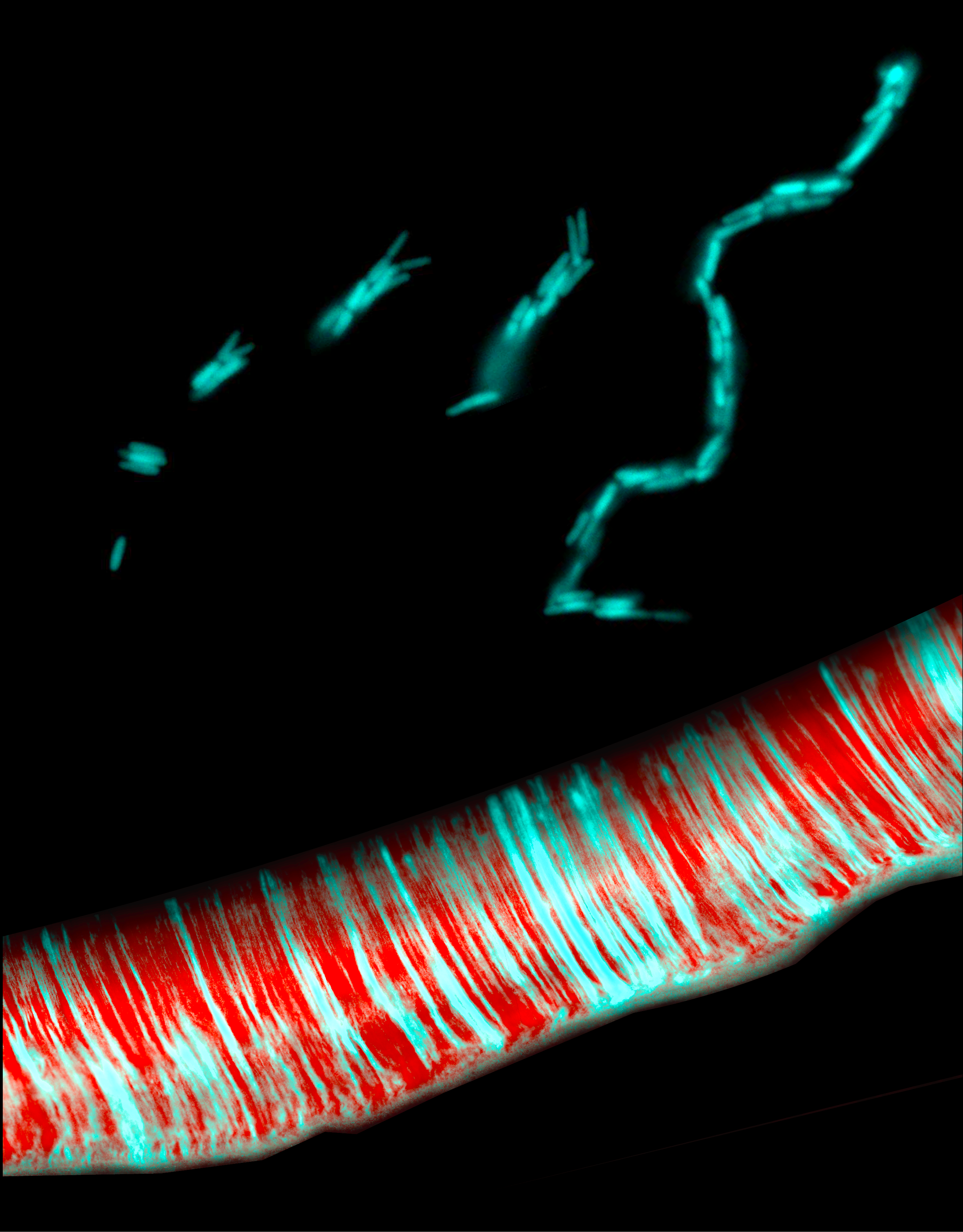Allison Lab Discovers Evidence of Multicellularity in Single Cell Organism
By Jerry Grillo
Researchers in the Wallace H. Coulter Department of Biomedical Engineering at Georgia Tech and Emory University have uncovered something new in one of the most studied organisms on Earth, and their discoveries could impact the treatment and prevention of devastating bacterial diseases.
Escherichia coli, or E. coli, gets a bad rap, and for good reason. This diverse group of bacteria that live in our intestines are mostly harmless and play an important role in sustaining a healthy digestive system. But some E. coli are among the most virulent disease-causing micro-organisms.
Pathogenic E. coli takes a deadly, costly toll on humanity, costing billions of dollars to treat and killing millions of people worldwide each year. It’s responsible for diarrheal diseases, peritonitis, colitis, respiratory illness and pneumonia, and other illnesses, and is the main cause in 80% of urinary tract infections, which are the most common bacterial infection.
Consequently, researchers have been keen to learn everything they can about E. coli for the past century or so. They have probed it from every angle, synthesized it, scrutinized it to the extent that, many people believe, there isn’t much else to learn.
“It’s probably the best studied and best understood organism on the planet,” said Kyle Allison, assistant professor in the Coulter Department. “And so, there’s a tendency among microbiologists, particularly in the last 20 years or so, to focus more on other microbes.”
But Allison and his colleagues have taken a closer look at E. coli and their research is yielding novel insights, and raising new questions, about of this prevalent unicellular organism. For one thing, it appears that E. coli may not always be unicellular. The research team explained it all in their study, “Evidence of a possible multicellular life cycle in Escherichia coli,” published this month in the journal iScience.
“We’ve identified some things that have never been seen before in bacteria,” said Allison, whose Emory-based lab closely studies individual bacteria to better understand antibiotic resistance and multicellular biofilms. Collaborating with Allison were two members of his lab, graduate researcher Devina Puri, who was the lead author, and postdoctoral researcher Xin Fang.
Microbe Communities
In nature, bacteria live in communities called biofilms, which are clusters of microbes encased in a self-made, self-sustaining slime matrix, and attached to many kinds of wet surfaces. They’re everywhere around us and inside of us. Common, everyday examples of biofilms include dental plaque and pond scum.
They can grow on plant and animal tissue, like the inside of our digestive tract, and cause serious infections. On top of that, the bacteria living inside a biofilm’s protective matrix are less likely to be affected by antibiotics.
“We know that biofilms are clinically important, particularly in relation to infection,” said Allison, who noted that approximately 80% of all bacterial infections have a biofilm component. “And almost any bacteria that’s ever been studied can make them.”
For this study, Allison’s team developed devices that combined microfluidics and agarose pads (which are used for live cell imaging) and used automated microscopy to track and record morphogenesis in E. coli.
They discovered something new – a multicellular self-assembly process in E. coli. Researchers observed unattached, single-celled organisms combining into four-cell rosettes, a natural multicellular formation thought to be uncommon in bacteria.
“Rosettes are rather significant in higher organisms, like mammals, because they initiate developmental processes like embryogenesis,” Allison said.
Multicellular Chains
They observed E. coli rosettes grow into constant-width chains, which continue growing for 10 generations before attaching to a surface and creating a biofilm. They saw and recorded the bacterial processes that had never been seen or recorded before.
“What we’re seeing here is bacteria maybe are not what we’ve considered them to be in the past,” Allison said. “My suspicion is that what we found is far more common that we knew.”
What they learned about E. coli and biofilms has implications for synthetic biology, the treatment and prevention of bacterial diseases, and our understanding of multicellular development. For example, Allison can see his lab’s study being useful as a blueprint for other areas of research – biofilm engineering, for example, which harnesses the beneficial uses of microbial communities, resulting in programmable biofilms.
“Based on what we’ve learned, probably the most effective approach to biofilm engineering is to let the organisms do what they want to do,” Allison said. “Then, for the last stage, the idea would be to program it to do what you need it to do – create a molecule for drug development, express an enzyme to help degrade a bioplastic, or something harmful in the environment. Our work gives some clear evidence on how to proceed.”
CITATION: Devina Puri, Xin Fang, Kyle R. Allison. “Evidence of a possible multicellular life cycle in Escherichia coli.” iScience (Jan. 2023). https://doi.org/10.1016/j.isci.2022.105795
FUNDING: This work was supported by funding from the NIH Director's Early Independence Award to Kyle R. Allison (NIH DP5OD019792)
Latest BME News
Jo honored for his impact on science and mentorship
The department rises to the top in biomedical engineering programs for undergraduate education.
Commercialization program in Coulter BME announces project teams who will receive support to get their research to market.
Courses in the Wallace H. Coulter Department of Biomedical Engineering are being reformatted to incorporate AI and machine learning so students are prepared for a data-driven biotech sector.
Influenced by her mother's journey in engineering, Sriya Surapaneni hopes to inspire other young women in the field.
Coulter BME Professor Earns Tenure, Eyes Future of Innovation in Health and Medicine
The grant will fund the development of cutting-edge technology that could detect colorectal cancer through a simple breath test
The surgical support device landed Coulter BME its 4th consecutive win for the College of Engineering competition.








